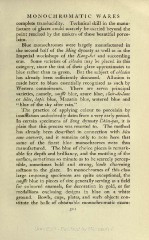Page 385 - Oriental Series Japan and China, Brinkly
P. 385
MONOCHROMATIC WARES
complete translucidity. Technical skill in the manu-
facture of glazes could scarcely be carried beyond the
point reached by the makers of these beautiful porce-
lains.
Blue monochromes were largely manufactured in
the second half of the Ming dynasty as well as in the
Imperial workshops of the Kang-hsi and succeeding
eras. Some varieties of celadon may be placed in this
category, since the tint of their glaze approximates to
blue rather than to green. But the subject of celadon
has already been sufficiently discussed. Allusion is
made here to blues essentially recognised as such by
Western connoisseurs. There are seven principal
varieties, namely, souffle blue, azure blue, clair-de-lune
or lilac, lapis blue, Mazarin blue, watered blue and
" blue of the sky after rain."
The practice of applying colour to porcelain by
insufflation undoubtedly dates from a very early period.
In certain specimens of Sung dynasty Chun-yao, it is
plain that this process was resorted to. The method
has already been described in connection with bleu
sous couverte, and it remains only to note here that
some of the finest blue monochromes were thus
manufactured. The blue of choice pieces is remark-
able for depth and brilliancy, and the mottling of the
surface, sometimes so minute as to be scarcely percep-
tible, sometimes bold and strong, lends charming
softness to the glaze. In monochromes of this class
large imposing specimens are quite exceptional, the
souffle blue in pieces of size generally serving as a field
for coloured enamels, for decoration in gold, or for
medallions enclosing designs in blue on a white
ground. Bowls, cups, plates, and such objects con-
stitute the bulk of obtainable monochromatic exam-

